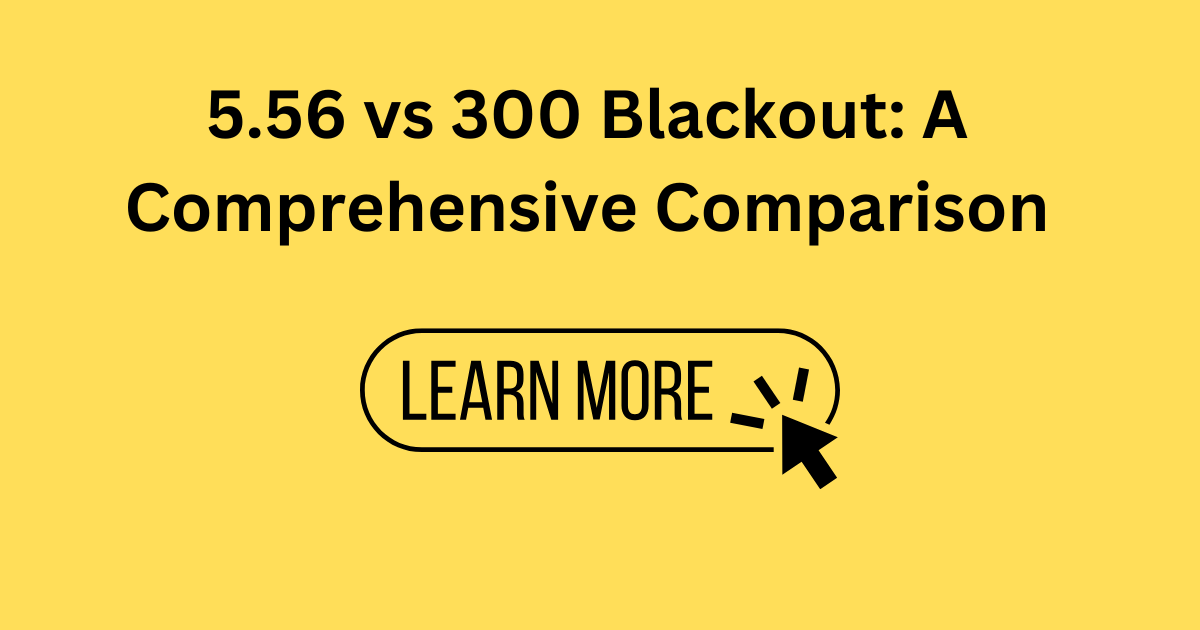When discussing modern rifle cartridges, the debate of 5.56 vs 300 Blackout is one that frequently comes up among firearm enthusiasts, hunters, and tactical operators. Both calibers offer unique advantages, but understanding their specific applications can help you make an informed decision. In this article, we’ll delve into the history, performance, applications, and pros and cons of each round, providing you with a thorough comparison.
History of 5.56 and 300 Blackout
Origins of the 5.56 NATO
The 5.56×45mm NATO was introduced in the 1960s as the standard rifle cartridge for the U.S. military. Designed for lightweight rifles like the M16, this caliber prioritizes high velocity, flat trajectory, and manageable recoil. Over decades, it has proven its effectiveness in combat scenarios and remains a staple in both military and civilian applications.
Birth of the 300 Blackout
In contrast, the 300 AAC Blackout (7.62×35mm) was developed in the early 2000s by Advanced Armament Corporation (AAC). This round was designed to offer better performance in suppressed rifles and provide more stopping power at subsonic velocities, making it a favorite for special operations and hunters. Unlike the 5.56 NATO, the 300 Blackout can be used in short-barrel rifles (SBRs) and excels in close-quarters engagements.
Ballistic Performance: 5.56 vs 300 Blackout
Velocity and Trajectory
- 5.56 NATO: Known for its speed, the 5.56 can achieve velocities exceeding 3,000 feet per second (fps) with a flat trajectory, making it ideal for long-range accuracy.
- 300 Blackout: While slower, averaging around 2,200 fps with supersonic loads and 1,050 fps with subsonic loads, the 300 Blackout offers heavier projectiles. This results in greater energy transfer on impact but less effective long-range performance compared to the 5.56.
Effective Range
- 5.56 NATO: The effective range extends up to 500-600 yards, making it suitable for medium to long-range shooting.
- 300 Blackout: Designed for close to medium ranges, its effective range typically caps at 300 yards with supersonic rounds and around 200 yards for subsonic loads.
Energy and Stopping Power
- 5.56 NATO: While fast, the lighter projectile (generally 55-62 grains) means less stopping power compared to the 300 Blackout.
- 300 Blackout: The heavier bullets (110-220 grains) pack a punch, making it more effective against targets that require greater energy transfer.
Applications: Which One Should You Choose?
Hunting
- 5.56 NATO: Often used for small to medium game like coyotes or hogs. However, its lighter projectiles may struggle against larger animals.
- 300 Blackout: A better choice for medium-sized game like deer, especially in states where minimum caliber restrictions apply. The heavy projectiles ensure more ethical kills.
Home Defense
- 5.56 NATO: Offers high accuracy and penetration but can pose a risk of over-penetration in home defense scenarios.
- 300 Blackout: Subsonic rounds reduce noise and limit over-penetration, making it an excellent option for home defense in urban environments.
Tactical and Military Use
- 5.56 NATO: Favored for its accuracy at range and the ability to carry more ammunition due to its lightweight design.
- 300 Blackout: Designed for suppressed shooting and close-quarters combat, it shines in special operations or urban warfare.
Key Advantages of 5.56 vs 300 Blackout
Advantages of 5.56 NATO:
- Cost-Effective: Ammo is widely available and typically cheaper than 300 Blackout.
- Extended Range: Superior long-range accuracy due to its high velocity and flat trajectory.
- Lightweight: Allows users to carry more rounds during extended missions or hunts.
- Widely Adopted: Most AR-15 rifles are chambered for 5.56, offering versatility.
Advantages of 300 Blackout:
- Superior Suppression: Operates effectively with subsonic ammunition, making it quieter for suppressed use.
- Stopping Power: Heavier projectiles provide better performance against targets requiring more energy transfer.
- Versatility: Can switch between subsonic and supersonic loads without modification to the rifle.
- Short Barrel Optimization: Retains performance in SBRs, unlike the 5.56 which loses effectiveness in shorter barrels.
Drawbacks: 5.56 vs 300 Blackout
5.56 NATO:
- Less effective in suppressed setups.
- Lighter projectile means less stopping power.
- Over-penetration concerns in home defense.
300 Blackout:
- More expensive and less widely available than 5.56 ammo.
- Limited long-range effectiveness.
- Heavier rounds reduce the amount of ammunition you can carry.
Cost Comparison
The price of ammunition plays a significant role in choosing between the 5.56 vs 300 Blackout. On average:
- 5.56 NATO: Costs around $0.30-$0.50 per round.
- 300 Blackout: Ranges from $0.70-$1.50 per round, depending on whether it’s supersonic or subsonic.
If you’re on a tight budget or plan to shoot frequently, the 5.56 offers more affordability.
Rifle Compatibility
One of the significant advantages of both calibers is their compatibility with the AR-15 platform. Switching between 5.56 and 300 Blackout typically requires only a barrel change, as they share the same magazines and bolt carrier groups. However, always double-check your rifle’s chambering to avoid accidents.
Real-World Scenarios
Scenario 1: Hunting in Dense Woods
A hunter in heavily wooded areas may prefer the 300 Blackout for its stopping power and performance in short-barrel rifles. The reduced noise from subsonic rounds can also prevent spooking nearby animals.
Scenario 2: Range Shooting
For competitive shooting or training at the range, the 5.56 is a clear winner due to its cost efficiency and long-range accuracy.
Scenario 3: Urban Home Defense
Homeowners concerned about noise and over-penetration may lean towards the 300 Blackout with subsonic ammunition, which is quieter and safer in close quarters. Learn more
Final Thoughts: 5.56 vs 300 Blackout
The choice between 5.56 vs 300 Blackout ultimately depends on your intended use. If you need an affordable, versatile, and long-range option, the 5.56 NATO is a reliable choice. On the other hand, if you prioritize stopping power, suppressed performance, and close-range effectiveness, the 300 Blackout may be your best bet.
For those who want the flexibility to switch between both calibers, investing in an AR-15 platform compatible with both rounds is a practical solution. No matter your decision, understanding the strengths and limitations of each cartridge ensures you’re equipped for success in any scenario.












